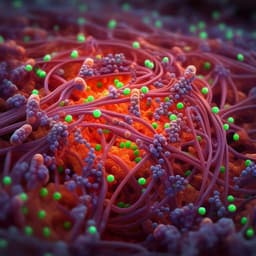
Medicine and Health
In vivo evolution of an emerging zoonotic bacterial pathogen in an immunocompromised human host
A. Launay, C. Wu, et al.
Discover the fascinating adaptive evolution of *Bordetella hinzii*, a zoonotic pathogen, in a patient with interleukin-12 receptor β1 deficiency. Researchers A. Launay, C.-J. Wu, A. Dualanto Chiang, J.-H. Youn, P. P. Khil, and J. P. Dekker reveal how genomic changes led to significant diversification and metabolic adaptations in the pathogen, highlighting the influence of the host's immune response on evolution after zoonotic infections.
~3 min • Beginner • English
Introduction
The study investigates how an emerging zoonotic bacterium, Bordetella hinzii, adapts within a human host who is immunocompromised due to autosomal recessive IL-12Rβ1 deficiency. Prior work on within-host evolution has focused on established pathogens under pressures such as antibiotics and immune responses, revealing processes like clonal selection, hypermutation, and genome reduction. B. hinzii, originally associated with poultry and related to B. pertussis, has been increasingly identified in human disease. The research question centers on identifying the genetic mechanisms and selective forces that drive within-host adaptation of B. hinzii after a zoonotic host jump, particularly in the context of impaired IFN-γ–mediated immunity. The purpose is to define mutation rates, spectra, and targets of selection during chronic infection, and to assess how host immune phenotype and oxidative stress shape pathogen evolution. The study is important for understanding pathogen emergence, adaptation dynamics in immunodeficient hosts, and potential parallels with human-restricted Bordetella pathogens.
Literature Review
Prior studies of chronic infections in immunodeficient patients have illuminated within-host evolutionary dynamics, including genetic diversification with purifying selection, clonal sweeps, trade-offs, hypermutation due to MMR defects, mobile element insertions, and large deletions/pseudogenization sometimes leading to attenuated pathogenicity. Evolution in chronic infections often parallels changes observed in human-restricted pathogens. B. hinzii, historically a poultry-associated species and a relative of B. pertussis, is recognized as a zoonotic opportunist in humans (respiratory infections, otitis media, bacteremia, endocarditis). An earlier case of chronic Salmonella in an IL-12Rβ1-deficient host showed elevated mutation rates and genome degradation, suggesting immune defects can modulate pathogen evolution. In Bordetella, regulatory systems like BvgS and two-component systems (e.g., Ris/Rrs) are key to virulence and adaptation, and human-adapted B. pertussis exhibits unusual metabolic specialization (TCA-dependent catabolism, reliance on gluconeogenesis), providing a contextual framework for interpreting metabolic mutations in B. hinzii during adaptation.
Methodology
- Patient and isolates: A patient with recessive IL-12Rβ1 deficiency and chronic B. hinzii infection was followed for 45 months. Serial blood and stool cultures yielded B. hinzii isolates with diverse morphologies. Mixed-morphotype colonies were separated by serial dilution and subculture.
- Phenotyping: Colony morphologies documented; evidence of autoaggregation/clumping assessed in broth.
- Antimicrobial susceptibility testing: Conducted at NIH and CDC using automated broth microdilution per CLSI methods.
- Whole-genome sequencing: Illumina NextSeq 500 used for all isolates; libraries prepared via TruSeq Nano or NEB kits; DNA quantified by Qubit and assessed by gel electrophoresis. Selected isolates (1G1, 1G2, 2B1, 2B3, 2G1) sequenced with PacBio RS II; assemblies generated using HGAP/SMRT Analysis; contigs curated; additional public B. hinzii genomes used for comparative analyses.
- Ancestral reconstruction: Two approaches. (1) Used a complete genome assembly (2B3, WT dnaQ) as reference; aligned isolate reads with Snippy; outgroups included; ancestral alleles inferred and integrated to reconstruct the likely last common ancestor (LCA); phylogeny validated with RAxML. (2) Built core-genome alignments and maximum-likelihood phylogenies (GTR+Γ) with RAxML; ancestral sequences inferred from the tree.
- Variant calling and annotation: Variants called with Snippy relative to the reconstructed LCA; medium/large deletions identified by VCFtools and manual inspection; functional annotation via Snippy/Prokka and custom scripts; pseudogenes defined as genes with nonsense or frameshifting indels truncating coding sequences.
- Phylogenetics: Separate trees for DnaQ WT and DnaQ E9G clades built from concatenated genomes/orthologs with RAxML; visualization highlighted morphotype relationships.
- Mutation accumulation (MA) experiments: Two designs.
1) WT isolates (two patient WT isolates and three ATCC strains) passaged on blood agar for 29 passages; multiple independent lineages per strain. DNA prepped and sequenced to estimate spontaneous mutation rates and spectra.
2) Parallel MA for DnaQ E9G hypermutator isolates using a high-resolution, multi-lineage design to quantify elevated mutation rates and spectra under controlled conditions.
Variants in MA experiments called with BWA/FreeBayes, filtered with BCFtools, and curated to retain de novo mutations from the final passage; BEDTools used to harmonize covered regions.
- Selection and convergence analyses: Genome-wide and gene-set dN/dS calculations performed. Homoplasy assessed with HomoplasyFinder on RAxML trees; mutations with consistency index <1 flagged. Simulation framework redistributed unique SNVs across the genome (100,000 iterations) stratified by divergence groups to identify genes with more mutations than expected by chance (empirical p-values). Gene ontology enrichment performed on frequently mutated genes and pseudogenes.
- Data and code: Sequencing data deposited in SRA PRJNA625734; data and scripts on Zenodo.
Key Findings
- Longitudinal sampling: 24 B. hinzii isolates from blood and stool over 45 months formed a clonal lineage with extensive genetic and phenotypic diversification; colonies exhibited diverse morphologies, often mixed within single colonies.
- Hypermutator emergence: 20/24 isolates carried an E96G substitution in the DNA polymerase III ε-subunit (DnaQ E9/E96 position), disrupting a conserved catalytic metal-binding residue and impairing proofreading.
- Elevated mutation rates: In vitro MA experiments showed spontaneous mutation rates in DnaQ E9G mutants >100-fold higher than WT B. hinzii; DnaQ E9G isolates exhibited greater genetic divergence from the inferred LCA in vivo.
- Dominance and diversification: Proofreading-deficient (DnaQ E9G) lineages dominated clinical cultures for at least 12 months and spawned multiple sub-lineages with additional mutations in DNA replication/repair genes (dnaE, translesion polymerase, mutM, mutY, uvrA/B/D), indicating compounded hypermutator phenotypes.
- Mutation spectra: Isolates clustered into three groups by spectra: WT DnaQ, DnaQ E9G, and DnaQ E9G plus base excision repair defects (mutM/mutY), the latter showing the highest mutation rates and divergence. Patient isolates had a significant excess of G:C→T:A transversions relative to MA experiments (Wilcoxon p=0.0071), implicating oxidative stress in vivo.
- Positive selection signals: Although the genome-wide dN/dS was ~0.81 (mild purifying selection), the 24 coding mutations in the DnaQ E9G clade founder had dN/dS=3.51 (Fisher’s exact p<0.016), consistent with strong positive selection early in the hypermutator lineage.
- Targets of adaptation: Simulations identified 134 genes enriched for mutations (unadjusted p<0.05), with top targets harboring 10–12 distinct mutations. Enrichments involved carbohydrate metabolism, gluconeogenesis, and long-chain fatty acid metabolism. Recurrently affected enzymes included TCA cycle (fumC, maeB/malate dehydrogenase, icd), and gluconeogenesis (pgiA, fbp). Regulatory histidine kinases (BvgS/BygS homolog) and a Ris/Rrs homolog also accumulated multiple mutations. Oxidative stress management systems (glutathione S-transferase, glutathione hydrolase, thioredoxin reductase trxB) were frequently mutated.
- Pseudogenization: 201 potential pseudogenes arose via indels/stop codons; ontology enrichment included transport, proteolysis, cell adhesion, heat response, and nitrogen regulation.
- Convergence and homoplasy: 85 mutations in 74 genes (1.3% of total) were homoplastic and not explained by shared ancestry, suggesting limited convergent evolution/recombination or reconstruction artifacts.
- Aggregation: Single colonies often comprised multiple morphotypes that were genetically distinct yet more related to each other than to isolates from other days, supporting CFUs as multicellular aggregates; in vitro separation introduced some additional diversity during passaging.
Discussion
The study demonstrates that in an IL-12Rβ1-deficient host, B. hinzii rapidly adapted via emergence of proofreading-deficient hypermutators (DnaQ E9G), which enabled accelerated discovery of beneficial mutations under host-imposed selection. Despite the general cost of high mutation rates, early positive selection for mutations in metabolism (TCA cycle, gluconeogenesis), redox homeostasis (glutathione/thioredoxin systems), and virulence regulation (two-component histidine kinases) likely conferred fitness advantages in the human host environment. The consistent excess of G:C→T:A transversions in vivo compared to controlled MA experiments implicates oxidative damage as a major driver of mutagenesis and selection, aligning with the patient’s impaired IL-12/IL-23–IFN-γ axis and altered handling of intracellular pathogens. Aggregation of genetically diverse lineages within single CFUs suggests structured populations where phenotypic plasticity and diversity may enhance survival under fluctuating host conditions. Over time, the DnaQ E9G hypermutator lineages were replaced, potentially due to mutational load, highlighting a dynamic balance between adaptive benefit and long-term fitness costs of hypermutation. Overall, the findings underscore how host immune phenotypes and associated oxidative pressures shape pathogen evolutionary trajectories following zoonotic infection.
Conclusion
This work provides a longitudinal genomic dissection of B. hinzii adaptation in an immunocompromised human host, revealing that loss of DNA polymerase III proofreading (DnaQ E9G) catalyzed rapid diversification and selection for mutations in metabolic pathways, oxidative stress responses, and regulatory systems. A distinctive oxidative mutational signature and strong positive selection in early hypermutator founders highlight the role of host-derived oxidative pressures in shaping within-host evolution. The observations of aggregation suggest population structure may facilitate coexistence of diverse sub-lineages. Future research should: (1) functionally characterize metabolic mutations (TCA/gluconeogenesis) and their impact on in vivo fitness; (2) dissect the effects of mutations in glutathione/thioredoxin systems on redox balance and oxidative stress resistance; (3) determine the roles of BvgS/BygS and Ris/Rrs homologs in B. hinzii virulence regulation and host adaptation; (4) quantify in vivo oxidative environments in immunodeficient hosts; and (5) elucidate the mechanisms and evolutionary consequences of aggregation in Bordetella during infection.
Limitations
- Single-patient case study limits generalizability across hosts and settings.
- Some methodological steps (e.g., separation of mixed morphotypes) required multiple in vitro passages, potentially introducing additional mutations that confound precise inference of in vivo diversity.
- dN/dS analyses at the gene level have limited power due to low mutation counts, warranting cautious interpretation.
- Homoplasy analysis identified a small fraction of mutations not explained by shared ancestry; these could reflect convergent evolution, recombination, or reconstruction artifacts.
- Oxidative stress was inferred from mutational signatures rather than directly measured in vivo.
- Potential biases from genome assembly/annotation and variant calling across mixed sequencing platforms (Illumina/PacBio).
Related Publications
Explore these studies to deepen your understanding of the subject.







